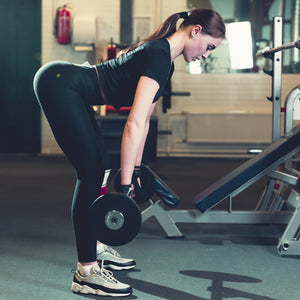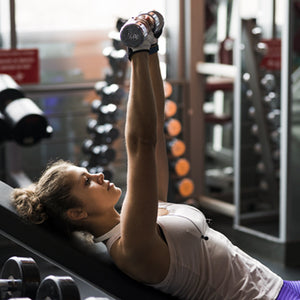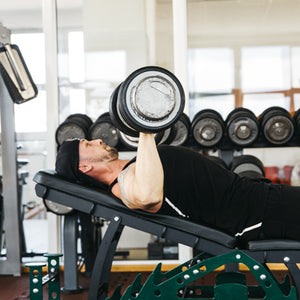FREE SHIPPING International Orders $275+

Powerlifting Platform Maturity: How to See More White Lights
There's an old saying about two bulls, and it has been beaten to death. The saying, not the bulls. But it goes like this...
Two bulls standing on a hill overlooking a pasture see a herd of cows. The young bull says, "Hey, let's run down there and shag a couple of those heifers." The old bull replies with, "Let's WALK down there and shag them ALL."
This is more than just a snarky remark. You've got to respect this way of thinking. Years of experience mold each of our individual approaches to everyday situations, whether we're conscious of it or not. This even includes the place where we think we have the most control. Not the cow pasture on the edge of a cliff. That's a different joke with a different animal. No, I'm talking about the platform.
Related: 53 Signs You Might Be a Powerlifter
I had the privilege to sit in as a side judge for the deadlift portion of a meet this past weekend. Never before had that story of the two horny bulls on a hill rang more true. Not only did this experience open my eyes and add to my knowledge as a lifter in the sport of powerlifting, but it showed me where and why a lot of people fail their attempts.
The red bulbs began to heat up and glow.
Now this was a charity event and many of the lifters were novices. This is in no way a condemnation of them, their lifts or their experience level. This is just my observation of when platform maturity comes into play and how it affected many of the attempts that I've witnessed in meets past and more recently judged.
Below are some of the reasons why lifters earn one or more red lights. They can apply to all lifters regardless of federation. Here they are in no particular order.

That's a good thing for the spectators who don't really want to sit there all day and clap for complete strangers every 60 seconds. But as nice as it is to be done before rush hour traffic hits, it's a double edged sword of fast flights and little time to rest and reset between attempts. Fast flights can play havoc on even the most experienced competitive lifter, but it can prove to be a nightmare for the novice lifter whose still learning when to get on line for the bathroom or how to time their warm up.
Although nobody timed out on Saturday, the lifters who were successful on their second and third attempts were the lifters who quickly got a feel for the speed of which the previous flight or the names in their flight were called. They adjusted their warm up or rest and attentiveness accordingly.
Meets usually don't move the speed that we'd like, so adaptation to a quick attempt turn-around or long cooling down period between attempts or events is important. The lifters who did not, hurried onto the platform in a panic and this led many to the next problem that I noticed, they rushed.
Sure, there are a couple dozen or more eyes blinking at you, a couple of camera flashes and the guy on the microphone mispronounced your name. But it's up to you - and you alone - to take control of the situation and make it as close to training as possible. Most of the time, that means slowing it down in the midst of the excitement and focusing on the lift rather than your surroundings.
I've seen many lifters who are psyched up, yelling, screaming, pacing, power-huffing ammonia caps, stalking the barbell, sneaking up on the damn thing and then BAM, they start their lift out of the groove or jump a command and miss. The lifter was so fired up and blinded from snot and tears that they tried to get their attempt over with as fast as possible.
Often times it was on a lift that based on their previous attempt, I thought they would have actually completed. That happened more than I thought it would last Saturday.
I suppose lifters feel a sense of urgency to begin their attempt because of the nature of the competition, where everyone waits their turn in a timed environment. That mindset is important when remembering to get to the platform promptly when called to avoid timing out and missing the attempt.
Being situationally aware of the approximate time elapsed is just doing your due diligence to yourself as a lifter, and this also means taking the time you need properly set up your lift as you do in training. It's not as flashy or entertaining for the strangers in the crowd, but your boring vanilla set up that you use in training is last shred of familiarity that you're left with up there.
If you're paying attention to YOUR attempt rather than the crowd, you should be able to approach the bar in a routine way, and that's the best way in my experience to start an attempt if getting credit for it is something on your to-do list.

I noted that several attempts were aborted while the bar was still moving fast enough for the lift to have a chance. Call it body position awareness, or lack of fortitude, or maybe the lifter felt something that wasn't right or whatever you will but the fact remains that you'll never get credit for the lift that you don't see to completion.
Aside from the lifters who stopped their attempt outright, a few lifters lost patience in the last few inches of lockout on the deadlift and put it in the judges hands when they hitched. I know how it is, I did that at my very first meet.
Lifter after lifter on their third attempt would slow down to a relatively manageable crawl with the hips so close to popping through to lock the weight and here comes Alfred HITCHcock with the ramp and jerk. That's a lot of effort with nothing to show for it at a powerlifting meet.
Start (if applicable) and rack commands are common culprits on bench, and holding your lockout until the down command, soft lockouts and lowering the bar under control in the deadlift can be easy mistakes for the novice lifter. In any event, screwing it up at the end of the lift is as good as missing it, no credit.
Exaggerating these commands in training is one way to circumvent a personal tragedy come meet day, but if you haven't done that, even just watching a few attempts before yours and taking mental notes can help. Or pretend that there's a stop sign after the lift and the judges are a bunch of highway patrol cruisers.
Your head might be telling your body to move at 100 mph during the lift, but you may need to consciously pump the brakes and open your ears for that head judges verbal commands once the hard part is over to ensure some white bulbs get hot.
I won't get into intricate detail on how to pick openers or subsequent attempts, but let's just say that I saw jumps of 95-100 pounds on lifts starting out in the low 400's. Also some of the shorter lifters required a couple of plates under their feet on the bench and those attempts took a little longer as the lifter waited to communicate that to the spotters and loaders. Again, not huge in any way and I'm not nitpicking on the noobs, just an observation.
With practice and a little situational awareness, you can help the judges ensure that your lifts will count toward your total on meet day. You owe it to yourself to take your attempt seriously by slowing it all down to set up properly.
Don't be the theatrical lifter who has the pre-lift ritual, smiles for the camera and then completely gets obliterated by gravity because their focus was misplaced. I hope for your sake that these tips and observations can help you earn more white lights as a lifter, and as many cows as you can handle as a young but experienced bull.
Two bulls standing on a hill overlooking a pasture see a herd of cows. The young bull says, "Hey, let's run down there and shag a couple of those heifers." The old bull replies with, "Let's WALK down there and shag them ALL."
This is more than just a snarky remark. You've got to respect this way of thinking. Years of experience mold each of our individual approaches to everyday situations, whether we're conscious of it or not. This even includes the place where we think we have the most control. Not the cow pasture on the edge of a cliff. That's a different joke with a different animal. No, I'm talking about the platform.
Related: 53 Signs You Might Be a Powerlifter
I had the privilege to sit in as a side judge for the deadlift portion of a meet this past weekend. Never before had that story of the two horny bulls on a hill rang more true. Not only did this experience open my eyes and add to my knowledge as a lifter in the sport of powerlifting, but it showed me where and why a lot of people fail their attempts.
The red bulbs began to heat up and glow.
Now this was a charity event and many of the lifters were novices. This is in no way a condemnation of them, their lifts or their experience level. This is just my observation of when platform maturity comes into play and how it affected many of the attempts that I've witnessed in meets past and more recently judged.
Below are some of the reasons why lifters earn one or more red lights. They can apply to all lifters regardless of federation. Here they are in no particular order.

Powerlifting: 5 Ways to See More White Lights
#1 - Improve Your Time Management
This meet was run very efficiently. I know that because I've been to a lot of meets that, although fun, ended closer to midnight than dinner time.That's a good thing for the spectators who don't really want to sit there all day and clap for complete strangers every 60 seconds. But as nice as it is to be done before rush hour traffic hits, it's a double edged sword of fast flights and little time to rest and reset between attempts. Fast flights can play havoc on even the most experienced competitive lifter, but it can prove to be a nightmare for the novice lifter whose still learning when to get on line for the bathroom or how to time their warm up.
Although nobody timed out on Saturday, the lifters who were successful on their second and third attempts were the lifters who quickly got a feel for the speed of which the previous flight or the names in their flight were called. They adjusted their warm up or rest and attentiveness accordingly.
Meets usually don't move the speed that we'd like, so adaptation to a quick attempt turn-around or long cooling down period between attempts or events is important. The lifters who did not, hurried onto the platform in a panic and this led many to the next problem that I noticed, they rushed.
#2 - Don't Rush Your Set Up
You train in a gym or a garage or a field somewhere, right? Likely, you approach the bar the same way set to set and rep to rep. So long as this isn't a Broadway production or a contortionist act or some kind of ritualistic mime show, this should be no different at a meet.Sure, there are a couple dozen or more eyes blinking at you, a couple of camera flashes and the guy on the microphone mispronounced your name. But it's up to you - and you alone - to take control of the situation and make it as close to training as possible. Most of the time, that means slowing it down in the midst of the excitement and focusing on the lift rather than your surroundings.
I've seen many lifters who are psyched up, yelling, screaming, pacing, power-huffing ammonia caps, stalking the barbell, sneaking up on the damn thing and then BAM, they start their lift out of the groove or jump a command and miss. The lifter was so fired up and blinded from snot and tears that they tried to get their attempt over with as fast as possible.
Often times it was on a lift that based on their previous attempt, I thought they would have actually completed. That happened more than I thought it would last Saturday.
I suppose lifters feel a sense of urgency to begin their attempt because of the nature of the competition, where everyone waits their turn in a timed environment. That mindset is important when remembering to get to the platform promptly when called to avoid timing out and missing the attempt.
Being situationally aware of the approximate time elapsed is just doing your due diligence to yourself as a lifter, and this also means taking the time you need properly set up your lift as you do in training. It's not as flashy or entertaining for the strangers in the crowd, but your boring vanilla set up that you use in training is last shred of familiarity that you're left with up there.
If you're paying attention to YOUR attempt rather than the crowd, you should be able to approach the bar in a routine way, and that's the best way in my experience to start an attempt if getting credit for it is something on your to-do list.

#3 - Show Patience in the Grind
This happens across all lifts but I noticed it in the deadlift the most. A lifter may have a preconceived notion of how fast the bar should be moving and panic when they perceive that it's not moving quickly enough.I noted that several attempts were aborted while the bar was still moving fast enough for the lift to have a chance. Call it body position awareness, or lack of fortitude, or maybe the lifter felt something that wasn't right or whatever you will but the fact remains that you'll never get credit for the lift that you don't see to completion.
Aside from the lifters who stopped their attempt outright, a few lifters lost patience in the last few inches of lockout on the deadlift and put it in the judges hands when they hitched. I know how it is, I did that at my very first meet.
Lifter after lifter on their third attempt would slow down to a relatively manageable crawl with the hips so close to popping through to lock the weight and here comes Alfred HITCHcock with the ramp and jerk. That's a lot of effort with nothing to show for it at a powerlifting meet.
#4 - Seeing the Lift Through
There are few things as tragic as spending all of that time and energy and money, training for weeks and months to enter a meet, to finally squat, press or pull your perfect attempt, only get red lights for jumping a command or dropping the bar from the knees.Start (if applicable) and rack commands are common culprits on bench, and holding your lockout until the down command, soft lockouts and lowering the bar under control in the deadlift can be easy mistakes for the novice lifter. In any event, screwing it up at the end of the lift is as good as missing it, no credit.
Exaggerating these commands in training is one way to circumvent a personal tragedy come meet day, but if you haven't done that, even just watching a few attempts before yours and taking mental notes can help. Or pretend that there's a stop sign after the lift and the judges are a bunch of highway patrol cruisers.
Your head might be telling your body to move at 100 mph during the lift, but you may need to consciously pump the brakes and open your ears for that head judges verbal commands once the hard part is over to ensure some white bulbs get hot.
#5 - The Small Stuff
Other minor snafus that separated those with a degree of platform maturity from those without were things like:- The lifter's attempt jumps too much weight
- The lifter not remembering to go to the scorer's table to give their next attempt and having to be called by the emcee to do so
- The lifter's lack of communicating with the officials if they had a special request
I won't get into intricate detail on how to pick openers or subsequent attempts, but let's just say that I saw jumps of 95-100 pounds on lifts starting out in the low 400's. Also some of the shorter lifters required a couple of plates under their feet on the bench and those attempts took a little longer as the lifter waited to communicate that to the spotters and loaders. Again, not huge in any way and I'm not nitpicking on the noobs, just an observation.
With practice and a little situational awareness, you can help the judges ensure that your lifts will count toward your total on meet day. You owe it to yourself to take your attempt seriously by slowing it all down to set up properly.
Don't be the theatrical lifter who has the pre-lift ritual, smiles for the camera and then completely gets obliterated by gravity because their focus was misplaced. I hope for your sake that these tips and observations can help you earn more white lights as a lifter, and as many cows as you can handle as a young but experienced bull.






